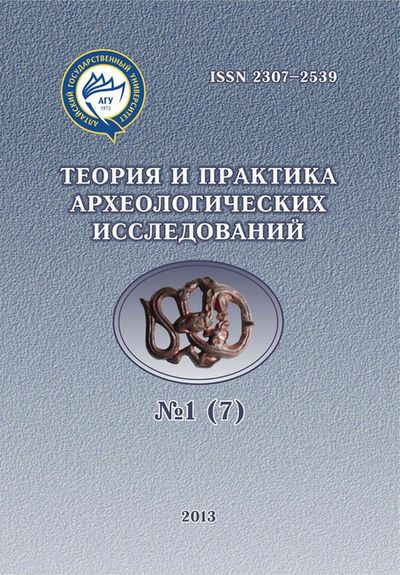ARTICLES WITH CHINESE LAC QUER FROM PAZYRYK COLLECTION OF THE STATE HERMITAGE
Abstract
The Pazyryk collection of the State Hermitage has a significant group of Chinese qi-lacquer decorated objects – (vessels, items of clothing and horse equipment, shields). They are concentrated mainly in late barrows (3rd century BC) and are predominantly represented by leather goods. The article describes these items and the results of a comprehensive study of coatings using different methods of analysis (microchemical, X-ray fluorescence, spectral, etc.).
A retrospective study of oriental lacquers and, urushiody (urushiol, and thitsiol, laccol) film formers which are contained in the sap of some species of trees of the sumac family, revealed that all coatings investigated by us consist of qi-lacquer, which is based on urushiol. Qi-lacquer is made from the sap of the lacquer tree Rhus verniciflua, cultivated in China in ancient times.
Coatings of items from the Pazyryk barrows have characteristics, techniques, and trace elements significantly different from the composition of materials of the first century AD from NoinUla (except for a few items that can be attributed to Noinulinskaya group). Respectively marked differences may not be temporary, but territorial. Judging by the inscriptions on the vessels from Noin-Ula, Han workshops, located in the northern regions of China may have inherited the tradition of the northern arts center, still existing in the 6th-5th centuries BC around the Jin principality. «Chinese» saddle ornaments of bone and wine cups with handles from the same cultural region, for example – from the kingdom of Qin, could get to Altai. Lacquered leather may have been manufactured in the south, in the kingdom of Chu. While small items of clothing and decorative horse equipment, were most likely cut in place from imported leather by the Pazyryk.
Downloads
Metrics
References
Баркова Л.Л. Курган Шибе и вопросы его датировки // АСГЭ. 1978. Вып. 19. С. 37–44.
Восточноазиатские лаки. Методика реставрации, исследования. М.: Изд. ВХНРЦ, 2000. 136 с.
Горбовский С.Е., Емельянов А.С., Емельянова А.Н. К вопросу о сумаховых дерматитах: (Об-зор литературы) // Вестник дерматологии и венерологии. 1974. №3. С. 16–20.
Грязнов М.П. Первый Пазырыкский курган. Л.: Изд. Государственного Эрмитажа, 1950. 91 с.
Дебен-Франкфор К. Древний Китай. М.: Астрель; АСТ, 2002. 160 с.
Елихина Ю.И. Китайские лакированные изделия эпохи Хань (206 г. до н.э. – 220 г. н.э.) из коллекции Государственного Эрмитажа // Россия-Китай: перекрестный год туризма. СПб.: Изд-во СПб ГАСУ, 2012. С. 57–61.
Киреев С.М., Шульга П.И. Сбруйные наборы из Уймонской долины // Изучение историко-культурного наследия народов Южной Сибири. Горно-Алтайск: Изд. ГАГУ, 2006. Вып. 3, 4. С. 90–107.
Киселев С.В. Древняя история Южной Сибири. М.: Изд-во АН СССР, 1951. 642 с.
Ковалев А.А. О связях населения Саяно-Алтая и Ордоса в V–III веках до н.э. // Итоги изуче-ния скифской эпохи Алтая и сопредельных территорий. Барнаул: Изд-во Алт. ун-та, 1999. С. 75–82.
Голиков В.П. Технологические особенности восточноазиатских лаковых изделий // Восточ-ноазиатские лаки. Методика реставрации, исследования: М.: Изд. ВХНРЦ, 2000. С. 38–57.
Кравцова М.Е. Лак // Духовная культура Китая: энциклопедия: в 5 т. / гл. ред. М.Л. Титарен-ко. М.: Вост. лит., 2010. Т. 6 (дополнительный). Искусство. С. 274–281.
Лубо-Лесниченко Е.И. Китайские лаковые изделия из Ноин-Улы // ТГЭ. 1969. Т. 10. С. 267–277.
Лубо-Лесниченко Е.И. Китай на шелковом пути (Шелк и внешние связи древнего и ранне-средневекового Китая). М.: Наука, Вост. литература, 1994. 326 с.
Мартынюк Д.Ф. Ядовитые растения Дальнего Востока. Благовещенск, 1956.
Новикова О.Г. Исследования химического состава восточных лаков. Области применения. Обзор литературы // Восточноазиатские лаки. Методика реставрации, исследования: М.: Изд. ВХНРЦ, 2000. С. 33–37.
Охрименко И.С., Верхоланцев В.В. Химия и технология пленкообразующих веществ. Л.: Химия, 1978. 392 с.
Рейбман А.И. Защитные лакокрасочные покрытия. Л.: Химия, 1982. 320 с.
Руденко С.И. Культура населения Горного Алтая в скифское время. М.; Л.: Изд-во АН СССР, 1953. 402 с.
Руденко С.И. Культура населения Центрального Алтая в скифское время. М.; Л.: Изд-во АН СССР, 1960. 360 с. + CXXVI табл.
Руденко С.И. Культура хуннов и Ноин-Улинские курганы. М.; Л.: Изд-во АН СССР, 1962. 206 с.
Степанова Е.В. Седла из Третьего Пазырыкского кургана // Культуры степной Евразии и их взаимодействие с древними цивилизациями. СПб.: ИИМК РАН; Периферия, 2012. Кн. 2. С. 446–454.
Тишкин А.А., Горбунов В.В. Горный Алтай в хуннуское время: культурно-хронологический анализ археологических материалов // Российская археология. 2006. №3. С. 31–40.
Тишкин А.А., Хаврин С.В., Новикова О.Г. Комплексное изучение находок лака из памятни-ков Яломан-II и Шибе (Горный Алтай) // Древние и средневековые кочевники Центральной Азии. Барнаул: Азбука, 2008. С. 196–200.
Чистякова А.Н. Иероглифическая надпись на лаковой чашке из кургана №20 в Ноин-Уле (Монголия) // Археология, этнография и антропология Евразии. 2009. №3. С. 59–68.
Шульга П.И. Синьцзян в VIII–III вв. до н.э. (Погребальные комплексы. Хронология и периодизация.). Барнаул: Изд-во АлтГТУ, 2010. 238 с.
Ancient Art from Hubei. Gaoxiong, 1997.
Burmester A. Technical Studies of Chinese Lacquer // N. Brommelle and P. Smith (eds.). Urushi: Proceedings of the 1985 Urushi Study Group, Getty Conservation Institute. Los Angeles, 1988. Р. 163–179.
Kamiya Y., Miyakoshi T. Synthesis of Urushiol components and analysis of Urushi sap from Rhus vernicifera // Journal of Oleo Science. 2000. V. 50.
Kamiya Y., Saito W., Miyakoshi T. Synthesis and identification of laccol components from Rhus succedanea lacquer sap // Journal of Oleo Science. 2002. №7. V. 51.
Keneghan В. Developing a methodology for the artificial ageing of urushi and a preliminary exami-nation of urushi-based conservation options // East Asian Lacquer: Material Culture, Science and Conservation. London, 2011.
Kenjo T. Scientific approach to traditional lacquer art // Urushi: Proceedings of the Urushi Study Group. Los Angeles: The Getty Conservation Institute, 1985. Р. 155–162
Kumanotani J., Achiwa M., Oshima R. and Adachi K. Attempts to understand Japanese lacquer as a superdurable material, in Cultural Property and Analytical Chemistry // International Symposium on the Conservation and Restoration of Cultural Property. Tokyo: Tokyo National Research Institute of Cultural Properties, 1979. Р. 51–62.
Kumanotani J. Urushi (oriental laquer) - a natural aesthetic durable and future-promising coating // Progress in Organic Coatings. 1995. V. 26. Р. 163–195.
Kumanotani J. Enzyme catalysed durable and authentic oriental lacquer: a natural microgelprintable coating by polysac-charide-glycoprotein-phenolic lipid complexes // Progress in Organic Coatings. 1998. V. 34. Р. 135–146.
Lu R., Yoshida T. Structure and molecular weight of Asian lacquer polysaccharides // Carbohydrate Polymers. 2003. V. 54. Р. 419–424.
Lu R., Sakai R., Ishimura T., Miyakoshi T. Characterization and comparison of Asian lacquer saps // Progress in Organic Coatings. 2008. V. 61, issue 1. P. 68–75.
Majima R. Uber den Hauptbestandteil des Japan-Lacks. VIII: Stellung der Doppelbindungen in der Seitenkette des Urushiols und Beweisfuhrung, dass das Urushiol eine Mischng ist // Ber. Dtsch. chem. Ges. Abt. B. (Abhandl.). 1922. Jg. 2, №1–2. S. 172–191.
McSharry C., Faulkner R., Rivers S., Shaffer M. and Welton T. The Chemistry of East Asian Lac-quer // A Review of the Scientific Literature, Reviews in Conservation. 2007. V. 8. P. 29–40.
Miniaev S., Elikhna J. On the Chronology of the Noyon uul Barrows // The Silk Road. 2009. Vol.7. Р. 21–30.
Pirazzoli-t’Serstevens M. Chinese Lacquerware from Noyon uul: Some Problems of Manufacturing and Distribution // The Silk Road. 2009. Vol. 7. Р. 31–41.
Silverstein, R., Basler, G., Morill, T. Identification spectrométrique de composes organiques. De Boëck Uni-versite. 1998.
Symes W., Dawson C. Separation and structural determination of the poison-ivy urushiol, cardanol and cardol // Nature. 1953. V. 171. №4358. P. 841–842.
Symes W., Dawson C. R. Poison ivy «urushiol» // Journal of the American Chemical Society. 1954. V. 76. P. 2959–2963.
Wana Y.-Y., Lub R., Duc Y.-M., Hondab T., Miyakoshi T. Does Donglan lacquer tree belong to Rhus vernicifera species? // International Journal of Biological Macromolecules. 2007. V. 41, issue 5. P. 497–503.
Urushi / Urushi Study Group, The Getty Conservation Institute. Tokio. 1985.
Copyright (c) 2017 Теория и практика археологических исследований

This work is licensed under a Creative Commons Attribution-NonCommercial-NoDerivatives 4.0 International License.
Theory and Practice of Archaeological Research is a golden publisher, as we allow self-archiving, but most importantly we are fully transparent about your rights.
Authors may present and discuss their findings ahead of publication: at biological or scientific conferences, on preprint servers, in public databases, and in blogs, wikis, tweets, and other informal communication channels.
Theory and Practice of Archaeological Research allows authors to deposit manuscripts (currently under review or those for intended submission to ABS) in non-commercial, pre-print servers such as ArXiv.
Authors who publish with this journal agree to the following terms:
- Authors retain copyright and grant the journal right of first publication with the work simultaneously licensed under a Creative Commons Attribution License (CC BY 4.0) that allows others to share the work with an acknowledgement of the work's authorship and initial publication in this journal.
- Authors are able to enter into separate, additional contractual arrangements for the non-exclusive distribution of the journal's published version of the work (e.g., post it to an institutional repository or publish it in a book), with an acknowledgement of its initial publication in this journal.
- Authors are permitted and encouraged to post their work online (e.g., in institutional repositories or on their website) prior to and during the submission process, as it can lead to productive exchanges, as well as earlier and greater citation of published work (See The Effect of Open Access).








2.jpg)



